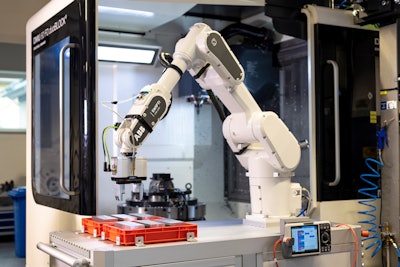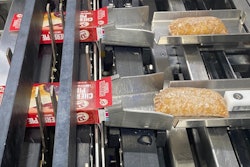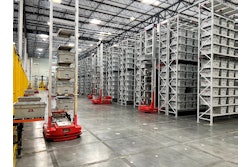
This content was written and submitted by the supplier. It has only been modified to comply with this publication’s space and style.
By 2027, the U.S. robotics market is expected to achieve a market volume over $9 billion, with an anticipated 5.62% compound annual growth rate (CAGR).
”The impact of U.S. labor shortages is increasingly being felt by many businesses as they struggle to keep pace with customer demands, even with the potential for some softening in the U.S. economy in the short-term,” said Bubnikovich. “This, combined with global political uncertainty, fragile supply chains and rising material costs, in addition to the growing trend of reshoring and nearshoring of operations, means more companies are adopting robotic automation to maximize flexibility, build resilience and adapt more sustainable production processes.”
Trend 1 – Demand for robots will increase in response to long term labor shortages and surge in re- and nearshoring
The impact of labor shortages is clearly felt across a wide range of industries and will continue well beyond 2023 as the effect of aging populations and a reluctance to take on low paid, dull, dirty and dangerous jobs increases. The Congressional Budget Office recently forecast that the size of the U.S. labor force will grow by just 0.2% annually from 2024 to 2031, and by 2030, it is predicted that more than 2.1 million U.S. manufacturing jobs will be unfilled2. his will hamper economic growth and present companies with the need to find new ways to plug gaps in workforces.
Demand for robots will be particularly strong in countries where companies are planning to re- or near-shore their operations to help improve their supply chain stability in the face of global uncertainty. In a survey of 1,610 companies carried out by ABB Robotics in 2022, 70 percent of US businesses said they are planning to re- or near-shore their operations, with 62% indicating they would be investing in robotic automation in the next three years.
“While much of the mainstream attention has focused on the impact of automation taking jobs, robots will increasingly perform the physically stressful tasks that people are reluctant to perform, helping to moderate industrial and commercial labor shortages,” said Bubnikovich. “The continuing advancements in ease of use and flexible performance of robots, including the development of collaborative models with larger payloads such as ABB’s GoFa™ and SWIFTI™ cobots, mean companies can address skills gaps and make better use of their existing workforces.  John Bubnikovich
John Bubnikovich
“We will also see robots taking on tasks in new sectors such as food processing and healthcare. For example, ABB robots are in operation at a White Castle frozen hamburger plant in Louisville, where a complete automated packaging system features three different types of robots handling three different functions. And, at the University of Texas Medical Branch (UTMB) in the Houston, ABB robots are revolutionizing antibody research by automating the testing process, increasing the number of tests done per day from 15 to 1000. We will see robots taking on more roles in similar settings going forward as labor shortages continue to impact many businesses,” said Bubnikovich.
Trend 2 – AI and autonomous technology will make robots easier to use, integrate and access – opening up additional opportunities in new industries
The recent development of ABB’s Visual Simultaneous Localization and Mapping (Visual SLAM) technology will enhance the productivity, flexibility, and speed of ABB’s range of Autonomous Mobile Robots (AMRs). Using AI-enabled 3D vision to perform location and mapping functions, Visual SLAM enables AMRs to make intelligent navigation decisions based on their surroundings. Solutions like these enable manufacturers to move away from traditional production lines towards integrated scalable, modular production cells, while optimizing the delivery of components across facilities.
Ongoing developments in artificial intelligence are powering autonomous grasping and positioning, which will expand the range of tasks robots can perform. This greater use of AI in robotics helps with tasks like the picking of non-uniform objects, which is on prominent display at a Burrtec Waste Industries material recovery facility in Riverside, California. Here, vision- and AI-enabled ABB delta robots scan materials on waste stream conveyor, picking a variety of contaminants from the line that the robot has learned are not able to be recycled.
At the same time, continued simplification of the software and controllers used to program robots will further reduce barriers to adoption by removing the need for specialist expertise.
“Over the past few years, the capabilities of Artificial Intelligence in the robotics realm have improved significantly,” said Bubnikovich. “As the technology continues to mature and become less complex, enabling ease-of-use and multiple applications, robotics will penetrate segments beyond traditional manufacturing and distribution, such as electronics, healthcare, e-commerce, pharmaceuticals and food service.”
Trend 3 – More specialist partnerships between industry and educators will support a new era of automation
With more companies using robots, there is a growing need for workers to learn new skills that will enable them to thrive in an automated environment. Achieving this will require a cooperative, multi-generational approach, from schools, colleges, and universities through to SMEs and supporting associations to provide training.
“Businesses in the future will need employees with experience in applying automation to perform a variety of processes,” said Bubnikovich. “As robots become more prevalent in factories, warehouses and other environments, there will be an increase in partnerships between robot OEMs, system integrators, manufacturers, and educators to provide people the necessary skills for an automated future. There are already more than 150 examples of ABB partnerships with educators in the United States, where our robots, RobotStudio® simulation and programming software, and Augmented Reality and Virtual Reality tools are used to teach students of all ages the skills needed to program and use robotic automation.”
The future
“Disruption and uncertainty are driving new business models, compelling companies to think differently about the way they operate. Scalable, flexible and capable of handling an expanding range of tasks, robots are becoming the new paradigm in making businesses more resilient in response to these external forces,” said Bubnikovich.
“As this all unfolds, the successful implementation of robotic automation will require a layer of qualified human engagement to achieve the best possible outcomes. As new technologies continue to make robots easier to use and deploy, we see 2023 as a year of opportunity that will enable companies and their workforces to reach new levels of productivity, efficiency and flexibility.”
ABB’s investment to support the future of robotics
ABB is supporting the anticipated robotics growth in the United States by investing over $22 million and creating highly skilled jobs in manufacturing, innovation and distribution operations.
Robotics specific investment projects underway across the U.S. include Auburn Hills, Mich.; Atlanta; and Houston.


























